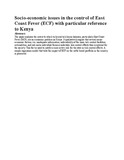| dc.contributor.author | Mwega, FM | |
| dc.date.accessioned | 2013-07-05T15:25:38Z | |
| dc.date.available | 2013-07-05T15:25:38Z | |
| dc.date.issued | 1986-10 | |
| dc.identifier.citation | International Journal of Tropical Insect Science / Volume 7 / Issue 05 / October 1986, pp 641-645 | en |
| dc.identifier.uri | http://journals.cambridge.org/action/displayAbstract?fromPage=online&aid=7461024 | |
| dc.identifier.uri | http://erepository.uonbi.ac.ke:8080/xmlui/handle/123456789/45925 | |
| dc.description.abstract | The paper analyses the extent to which ticks and tick-borne diseases, particularly East Coast Fever (ECF), are an economic problem in Kenya. It qualitatively argues that several socio-economic factors, viz. inadequate information, indivisibility of the main tick control facilities, externalities, and risk make individual farmers undertake less control efforts than is optimal for the society. This fact is used to justify a more active role for the state in tick control efforts. A simple regression model that tests the impact of ECF on the cattle breed portfolio in the country is presented. | en |
| dc.language.iso | en | en |
| dc.publisher | University of Nairobi | en |
| dc.title | Socio-economic Issues In The Control Of East Coast Fever (ECF) With Particular Reference To Kenya | en |
| dc.type | Article | en |
| local.publisher | School of Economics | en |

